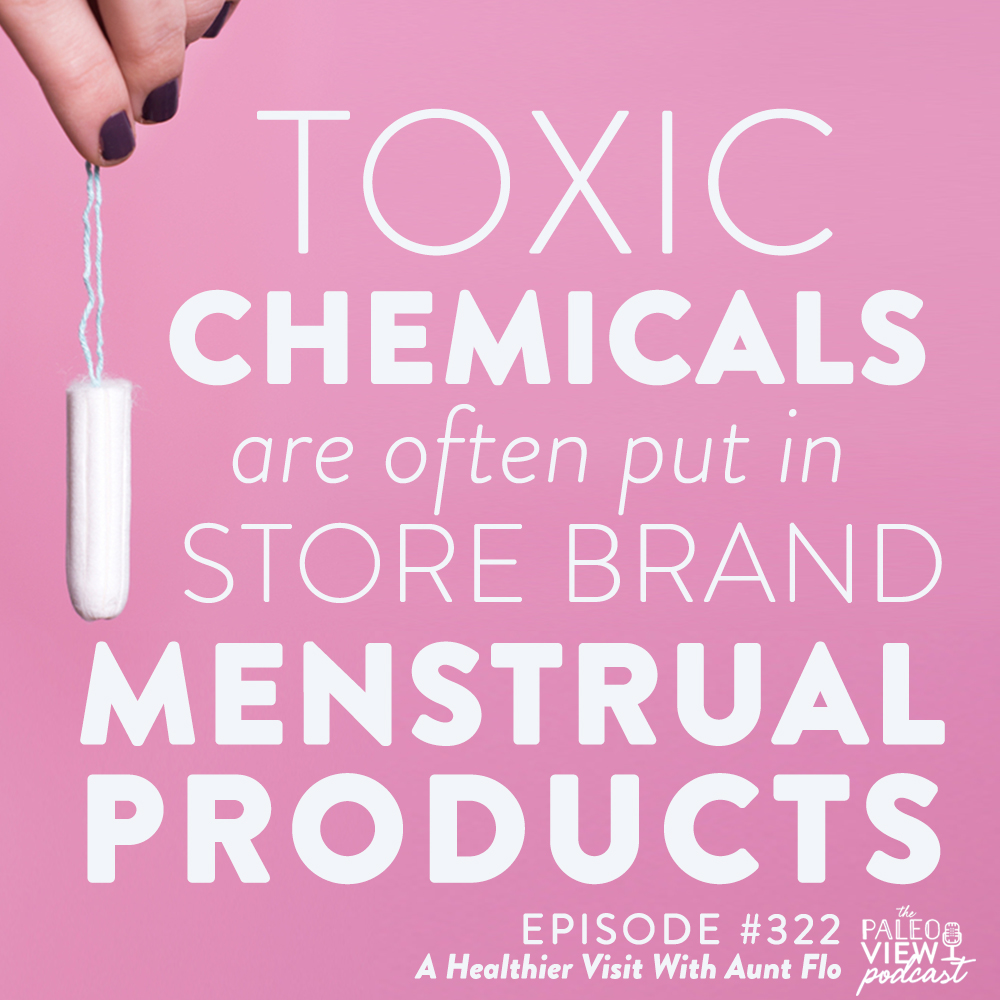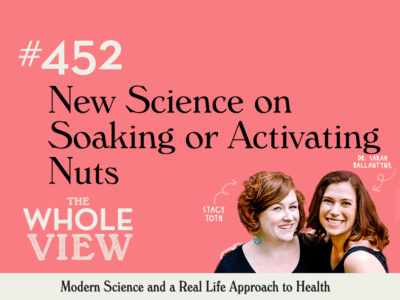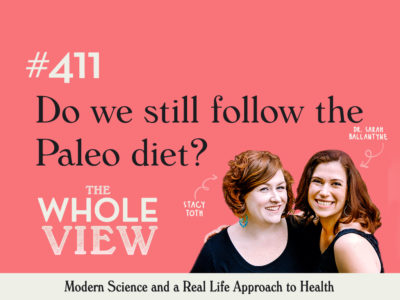In this episode, Stacy and Sarah are getting up close and personal as they answer all your questions about menstruation! Why are conventional pads and tampons dangerous? What are the signs of Toxic Shock Syndrome? What safer period products and brands should I be using? And how the heck do I use a menstrual cup?!
Click here to listen in iTunes
or download and listen by clicking the PodBean Player below
![]()
If you enjoy the show, please review it in iTunes!
The Paleo View (TPV), Episode 322: A Healthier Visit With Aunt Flo
-
- (0:00) Intro
- (0:40) Getting right to today’s topic: menstruation!
- Disclaimer: If you typically listen to our podcast with your kids in the room, please note that this episode discusses female reproductive anatomy and feminine hygiene products.
- Today we’re answering your questions about menstruation, including what products you should and shouldn’t be using, the chemicals and questionable substances used in conventional products, and how it impacts female health.
- This topic came about back in September when Stacy’s period caught her by surprise on a trip. She was traveling without a menstrual cup (which she’s used for 7+ years) and had to make the decision between pads and tampons.
- When Stacy switched to a cup, it reduced the length of her period, as well as the amount and intensity of cramping.
- Sharing her experience on social media sparked a lot of questions about the cup and safer menstruation practices, so we’re here to dive into the science behind your questions!
- Sarah rarely uses tampons because intuitively, they always felt unsafe to her. As she dove into the research, it backed up her suspicions. But the good news is that there are so many safer options!
- Stacy and Sarah take a walk down memory lane, remembering the pads that were available on the market when they first started menstruating.
- Listeners – if you have a menstruation product and you love it, go to Stacy’s Instagram and/or Sarah’s Instagram posts for this podcast episode and leave a comment about what you’re using and why you love it!
- (14:29) So what is the problem with conventional pads and tampons?
- It boils down to the fact that these materials aren’t regulated. The companies are trying to solve the problem of “does this absorb liquid” without considering other important health factors.
- The vagina and vulva are mucus membranes that are highly absorbent, so there’s the potential for those areas to absorb the chemicals and other known problematic materials used in conventional products. This can lead to chronic health problems like cancer.
- Research was almost non-existent for vaginal health until the 1990s. The earliest research was on sexually transmitted infections and how personal lubricants could affect the rate of infection transmission.
- These studies discovered chemicals like glycerine – which is still used in personal lubricants today – damages and irritates the vaginal barrier tissue.
- Funding for women’s health studies is stunningly low. Thir party organizations like non-profit advocacy groups have taken on the responsibility of doing this type of testing because it’s incredibly important.
- (20:55) Female sex organs are highly absorptive
- Female sex organs are “self-cleaning” because they need to be able to get rid of the foreign material introduced during intercourse. It’s lined with mucus which provides a barrier and prevents bacteria from latching on and washes away harmful microorganisms.
- Like our gut, skin, and sinuses, vaginal tissues (including the external parts) are also semi-permeable. But they’re much more absorptive than skin.
- Studies show hormones get into the bloodstream very easily through the vaginal barrier. One hormone, when taken both vaginally and orally, was 10x stronger when delivered vaginally. This means you need to be mindful of everything that comes into contact with that area!
- For more on the regulation (or lack thereof) of personal care products check out Episode 275: Cancer Risk from Personal Care Items.
- Beyond tampons and pads, also beware of vaginal wipes, personal lubricants, douches, vaginal perfumes – anything you’re putting in contact with your lower regions.
- Even though the vagina is more absorptive than the intestines, there has never been a peer-reviewed study that measures the absorption of pesticides, dioxins, etc, from tampons or pads into the vagina. Crazy!
- Always avoid personal care items with fragrances! Fragrances are a “catch all” category for companies to put any ingredient they want without disclosing it. There are harmful fragrances that are added to tampons and pads which are known endocrine disrupters.
- (29:32) Chemicals in conventional tampons and pads
- Dioxins. Women absorb more dioxins through tampons than food in polluted areas.
- Furans. A chemical used to bleach tampons so they’re white.
- Parabens. Endocrine disrupter and carcinogen.
- Pesticide residue. Third party testing has found at least 8 different detectable pesticide residues in one common brand of tampons.
- If you’re spending money for grass-fed and organic foods, and clean self-care products, this is something you need to be concerned about!
- (32:14) Toxic Shock Syndrome
- In the 70s and 80s there was a dramatic rise in toxic shock syndrome (TSS) when tampons became more widely used. At that time, 4 different types of synthetics were being used. After studies, 3 of those materials were removed from the market.
- TSS is caused by a toxin secreted by Staph. Aureus, a very common and problematic bacteria. During menses, the vagina creates a great breeding ground for Staph. Aureus and when you use a tampon, you’re creating an even better environment for this bacteria to grow.
- TSS can be fatal. It doesn’t occur frequently, but when it does, it requires medical care.
- Major symptoms of TSS include:
- Sudden high fever
- Dizziness when going from sitting to standing (caused by sudden low blood pressure)
- Lesser symptoms:
- Nausea
- Vomiting
- Rash resembling a sunburn, particularly on the palms of hands and soles of feet
- Muscle aches
- Confusion
- Headaches
- If you experience these symptoms, cease using a vaginal product and seek medical attention immediately. Treatment includes a high dose of antibiotics.
- Major symptoms of TSS include:
- Recent studies show that 100% cotton tampons potentially create a higher risk of TSS (versus synthetic/cotton blends tampons), though earlier studies showed they have a lower risk. So it’s not cut and dry.
- When it comes to menstrual cups, medical grade silicone cups have a lower rate of Staph. Aureus growth. Most cups on the market these days are medical grade silicone, but it’s important to check.
- Make sure you follow the recommended cleaning instructions when using a cup!
- TSS is not limited to using vaginal products. It can result from other means.
- About 80% of us make antibodies against Staph Aureus, so our bodies knock it out before becoming TSS.
- (47:12) Recommended menstrual products and brands
- Every woman is different so it’s important to experiment and find the right fit for your cervix, comfort, and lifestyle!
- Organic cotton disposable pads
- Natracare
- The Honest Co
- Organyc
- Seventh Generation
- Reusable pads
- Oko Creations
- Glad Rags
- Luna Pads
- Saathi Pads
- Pink Daisy
- Organic cotton tampons
- Cora
- Seventh Generation
- Natracare
- Maxim
- Puristics
- Organyc
- Reusable Natural Sponge Tampons
- Jade & Pearl
- Poseidon
- Constantia Beauty
- Natural Intimacy
- The Sea Sponge Company
- Menstrual Cups
- Diva Cup
- Lunette
- Yukki
- Anigan Evacup
- Fleurcup
- Super Jennie
- Lena cup
- Period Panties
-
-
- Modibodi
- PantyProp
- Lunapantie
- THINX
- Harebrained
- Anigan StainFree Panties
- Vv SkiVvys
- Dear Kate
-
- (53:22) Listener Questions
- “How do I choose the best cup for me?”
- Stacy swears by this quiz: https://putacupinit.com/quiz/
- Finding the right size cup for you is very important because if you’re using a cup that doesn’t fit you well, there’s a risk of a prolapsed bladder, cervix, and/or uterus.
- If your cup feels weird in any way, it’s the wrong size! If you find a cup doesn’t work for you, your next best options are a natural sponge or an external product like reusable pads or period panties.
- “How long does a cup last?”
- For Stacy, one cup lasted 6 years. The stem broke. So it’s a much more environmentally-friendly option!
- “I’m so intrigued but I can’t comprehend how you get it in and out, and it doesn’t spill?”
- Stacy says she’s never had a problem with the cup spilling (except for that one time her cup fell in the toilet!)
- The cup is also the only product she’s used that has an airtight seal so when you’re swimming, it keeps everything where it should be.
- When inserting, you fold the edges of the cup and insert it with a twisting motion. It should naturally unfold as you’re inserting.
- In terms of leakage, chances are incredibly slim that a cup of menstruation will spill all over you. However, if the cup overflows, a little leakage can occur.
- For removal, while sitting on a toilet, grab pinch the stem and squeeze the base of the cup to release the airtight seal. Then gently remove the cup. It should come out easily. Definitely practice this at home before attempting this in a public restroom.
- When in doubt, check out YouTube for “how to” videos.
- You don’t have to remove the cup every time you use the bathroom.
- It’s also more sterile! No external strings or material to absorb other body fluids.
- “Does it actually shorten your period?” and “Is there less blood?”
- Yes, it can shorten your period, and it can feel like there’s less blood, but the uterine lining is still shedding the same amount.
- How heavy your period or how long it lasts really depends on hormones, stress, thyroid, etc. Tampons are a physical stressor so it could be changing the quality of your period. Fragrances, chemicals, and materials like plastics can also mess with period quality.
- “Is there a downside for the cup holding liquid inside that long?”
- The downside is just creating an environment for Staph. Aureus to grow, which can turn into TSS. But this is a slim chance.
- Companies do make wipes for cleaning your cup during the day, but Stacy believes that it’s safer to just avoid removing your cup in public restrooms and therefore avoid exposing it to other potentially harmful bacteria.
- Stacy and Sarah recommend having two cups so you can sterilize one while using the other. Stacy sterilizes hers by running it through the dishwasher.
- “Cup versus soft disk?”
- Stacy doesn’t have experience with this. And it didn’t come up in Sarah’s research for the show. Stacy is weary of them because they contain plastic.
- Do you use one? Go to Stacy’s Instagram and/or Sarah’s Instagram posts for this podcast episode and leave a comment about what you’re using and why you love it.
- “Can menstrual cups be used safely with IUDs?”
- If your cup fits properly, it’s not touching your cervix so it shouldn’t be an issue (but check with your medical professional).
- “I have a 4th degree tear from a baby. Will a cup be comfortable?”
- You won’t know until you try, but make sure you get a cup that fits.
- Stacy recommends a natural sponge or a period panty if the cup doesn’t feel good.
- “I’m having a baby next month. What about post-partum?”
- Doctors recommend not inserting anything into your vagina for a period of time after giving birth due to risk of infection, so follow their advice!
- It’s okay to use the pads they give you at the hospital after giving birth – do what you need to do! – but then find a safer pad option using the list above.
- “How do I choose the best cup for me?”
- Get your questions in! We want to hear from you! And there’s no end to questions we can answer and topics we can address!
- Engage on social media! That’s how we get feedback!
- Thank you for listening
Relevant posts
A Question for Women’s Health: Chemicals in Feminine Hygiene Products and Personal Lubricants
Chem Fatale Report: Potential Health Effects of Toxic Chemicals in Feminine Care Products
Role of female intimate hygiene in vulvovaginal health: Global hygiene practices and product usage
Menstrual Cup Linked to Toxic Shock Syndrome, New Study Finds

—









